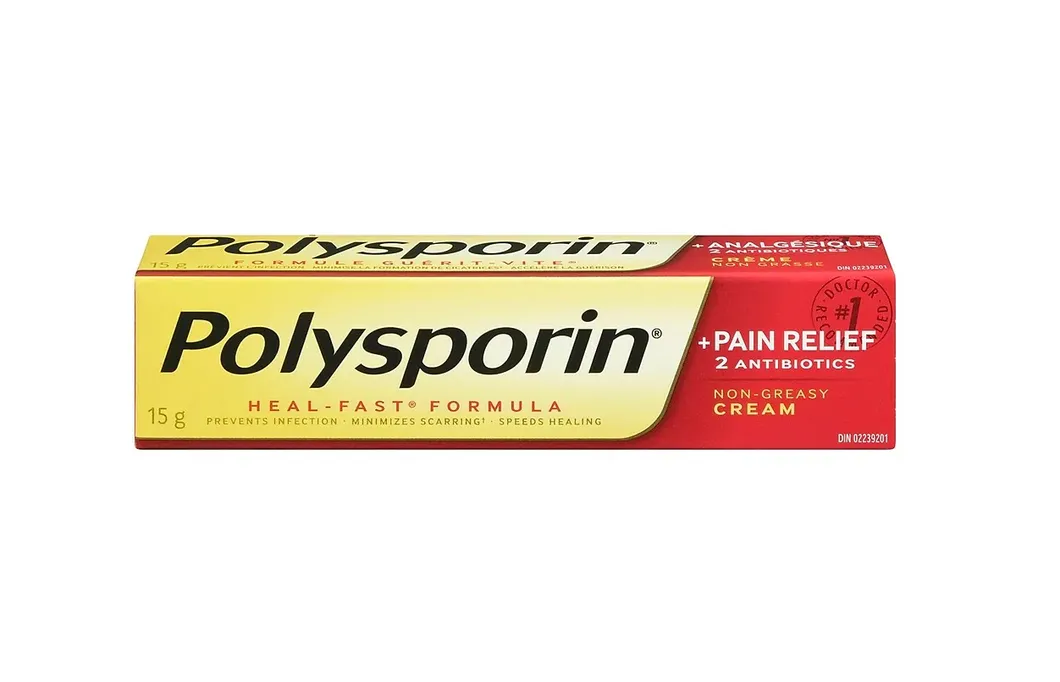Polysporin: Uses, Function, and Clinical Insights
Introduction to Polysporin
Polysporin is a widely used topical antibiotic ointment known for its ability to prevent infections in minor cuts, scrapes, and burns. It capitalizes on the synergistic action of its primary active ingredients—polymyxin B and bacitracin. These components belong to a class of antibiotics effective against a range of Gram-negative and Gram-positive bacteria. This formulation is part of a broader category of topical antimicrobials crucial for wound care, ensuring that minor abrasions do not escalate into serious infections.
What is Polysporin?
Polysporin is a trademarked name for a specific formulation of first-aid antibiotic ointments that exclude neomycin, which is present in its counterpart, Neosporin. The absence of neomycin reduces the risk of allergic reactions among sensitive individuals. As a readily accessible over-the-counter product, Polysporin is famed for its dual-antibiotic formulation that can be applied directly on the skin to avert bacterial invasions source. It primarily serves as an adjunct in wound management, providing a protective barrier against opportunistic infections.
Composition of Polysporin
Polysporin typically consists of:
-
Polymyxin B: This is an antibiotic primarily targeting the cell membranes of Gram-negative bacteria. By disrupting the bacterial cell wall, polymyxin B prevents the replication and spread of bacterial cells read more.
-
Bacitracin: This component works by inhibiting bacterial cell wall synthesis, making it effective against Gram-positive bacteria. It complements polymyxin B by broadening the spectrum of antibacterial action see study.
The meticulous composition ensures a comprehensive defense against bacterial colonization, particularly beneficial in preventing complex wound infections further details.
Approved Uses for Polysporin
Polysporin is primarily employed in preventing bacterial infections in minor wounds. The beneficial effects of its application include:
-
Preventing Infection: When applied promptly to a fresh wound, Polysporin functions as a first-line defense to barricade against pathogens that can complicate healing processes read more.
-
Minor Cuts and Scrapes: An average kitchen accident or playground scrape can become a gateway for bacteria like Staphylococcus aureus. Polysporin acts to seal the breach until the body’s natural defenses can take full charge.
-
Burns: Superficial burns compromise skin integrity, allowing bacteria easy access. Polysporin coats these areas with an antibiotic shield, minimizing the risk of bacterial invasions.
-
Wound Moisture Balance: Beyond its antibacterial properties, Polysporin maintains a moist wound environment crucial for optimal healing and epithelialization. Moist wound healing is preferred because it reduces cell death, wound pain, and scab formation source.
In practice, Polysporin serves as an integral component in home first-aid kits, substantiated by clinical use guidelines that underscore the importance of topical antibiotic therapy in managing minor skin injuries.
How Does Polysporin Work?
The efficacy of Polysporin is primarily grounded in the pharmacodynamics of its active constituents—polymyxin B and bacitracin.
Mechanism of Action
-
Polymyxin B: This works by binding to the phospholipids present in the bacterial cell membrane. It disrupts its integrity by altering membrane permeability, essentially causing the contents of the bacterial cell to leak out, leading to cell lysis and death. This action is particularly effective against Gram-negative bacteria, which have a unique membrane structure susceptible to polymyxins read more.
-
Bacitracin: It targets the cell wall biosynthesis of bacteria by interfering with the transport of key precursors needed for cell wall formation. This inhibition is particularly effective against Gram-positive bacteria, making it a useful agent against Staphylococcus species source.
The combination of these two mechanisms results in a broad-spectrum antibacterial action, reducing the risk of infections while promoting faster healing processes. The effectiveness of Polysporin in tackling bacterial infections aligns with clinical guidelines recommending such preventative measures, especially in settings where minor wound care is essential further reading.
The topical application of Polysporin maximizes its bactericidal potential directly on the skin, ensuring rapid onset and sustained antibacterial activity at the site of application. Its mode of action underlines the significance of combined antimicrobial strategies in enhancing patient outcomes and minimizing complications in wound management.
This detailed examination of Polysporin highlights its essential role in primary care and its pivotal action in the field of topical antibiotics. Its usage underscores comprehensive wound management strategies essential for mitigating complications in everyday injuries. Continue exploring advanced sections to learn more about specific clinical applications, dosing, and patient considerations.
Research Studies and Clinical Trials
Clinical Trials Focusing on Polysporin
Significant research has been conducted to evaluate the effectiveness of Polysporin and its components in specific clinical settings, underscoring its role in infection prevention and management. Notably, a critical clinical trial assessed the use of Polysporin Triple antibiotic ointment to reduce the incidence of catheter-related infections in hemodialysis patients. This study enrolled 169 patients reliant on central venous catheters, demonstrating a marked reduction in infections among the Polysporin-treated group compared to those receiving a placebo (34% versus 12%) (source). The findings of such studies have robust implications for preventing infections in clinical settings where vascular access is a requirement.
Comparative Efficacy and Recommendations
Numerous studies highlight the superior efficacy of Polysporin (and similar formulations) as compared to antiseptic treatments or other types of topical antibiotics. The PADIT Trial observed the limitations of traditional prophylactic treatments like cefazolin in preventing device-related infections, thereby highlighting the necessity for an augmented or combined prophylactic approach (PADIT Trial). Such comparative analyses fortify the case for using Polysporin as a reliable defensive layer in minor injury management, helping healthcare professionals endorse evidence-based wound care protocols.
Side Effects and Considerations
Common Side Effects
While Polysporin is generally well-tolerated, some individuals may experience certain side effects. These usually manifest as minor skin irritations, such as itching or rash, though they are rare. It’s crucial to monitor the wound site for any adverse reactions like allergic dermatitis, particularly in individuals with hypersensitivity histories to any antibiotic components, including bacitracin or polymyxin B.
Risk of Antimicrobial Resistance
Another significant consideration is the potential development of antibiotic resistance. While Polysporin is effective for topical applications, indiscriminate or overuse can contribute to broader issues of antibiotic resistance in medical contexts. Data from epidemiological studies on polymyxin-resistant bacteria illuminate the risks associated with acquiring resistance gene mutations upon repetitious use (study). Hence, it is vital for healthcare providers to stress appropriate use directives and educate patients about correct dosage and application frequencies.
Sensitivity to Components
Given the variability in individual sensitivities, it’s recommended that Polysporin use should be approached cautiously in patients known to have cross-sensitivities to similar compounds. Additionally, usage should be discontinued promptly in cases where local allergic reactions are observed, and alternative treatments should be considered.
Comparative Analysis: Polysporin vs. Other Topical Antibiotics
Comparing Formulations
When comparing Polysporin to other antibacterial ointments like Neosporin (which contains neomycin in addition to polymyxin B and bacitracin), the absence of neomycin in Polysporin reduces the risk of potential allergic reactions. Therefore, Polysporin might be preferred by individuals with known sensitivities to aminoglycosides, highlighting its niche in personalized minor wound management (case review).
Head-to-Head Efficacy
Comparative studies also indicate that although both Polysporin and its counterparts are effective in treating minor infections, Polysporin’s formulation without neomycin poses fewer risks of allergic hypersensitivity. Other topical antibiotics, while effective, may not provide the same spectrum of ease regarding skin-tolerance, particularly when applied to sensitive individuals or over large skin areas.
Future Directions in Clinical Practice
Innovations and Guidelines
The continued exploration of Polysporin’s utility lies in its adaptability across various clinical scenarios, amplifying its significance beyond typical consumer usage. Emerging guidelines have started to integrate research findings into practice, promoting layered defense mechanisms against infections particularly in vulnerable or compromised patient demographics.
Potential Research Pathways
Prospective research could delve deeper into Polysporin’s application in conjunction with other systemic antibiotics or antimicrobials in the management of more severe dermal infections. Future studies might focus on synergistic effects, optimizing dosages, and formulating even more effective compounds to circumvent established microbial resistance pathways (future research).
This exhaustive evaluation articulates how Polysporin remains a cornerstone in both household and clinical antibiotic options, providing an indispensable arsenal against minor wound-associated infections. Its role in preventive care continues to expand, supported by a growing body of clinical evidence advocating for its extensive application.








